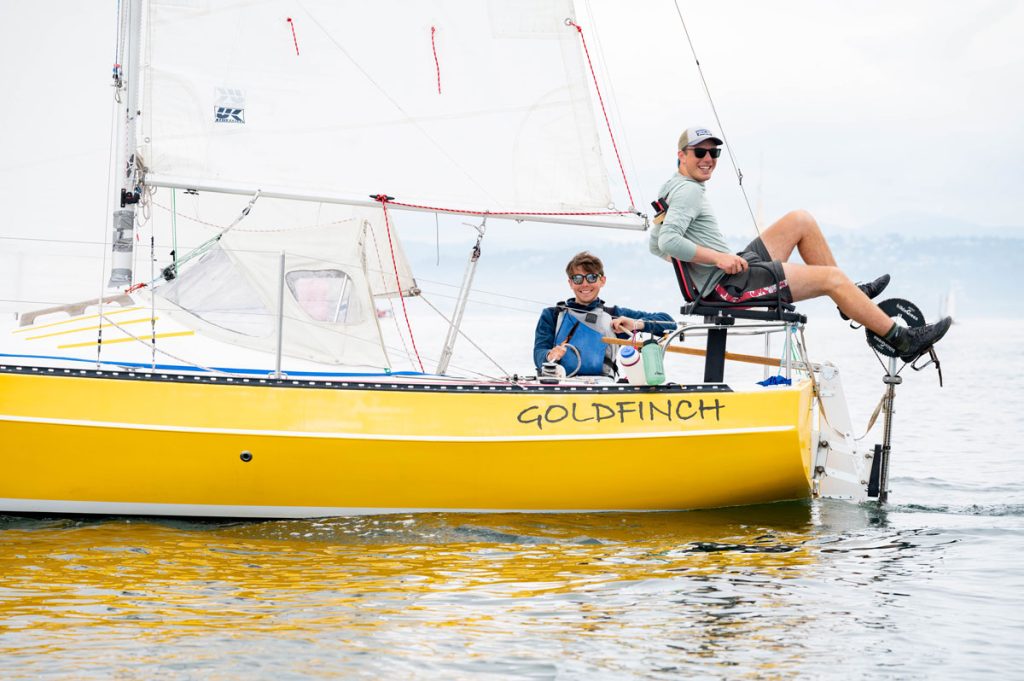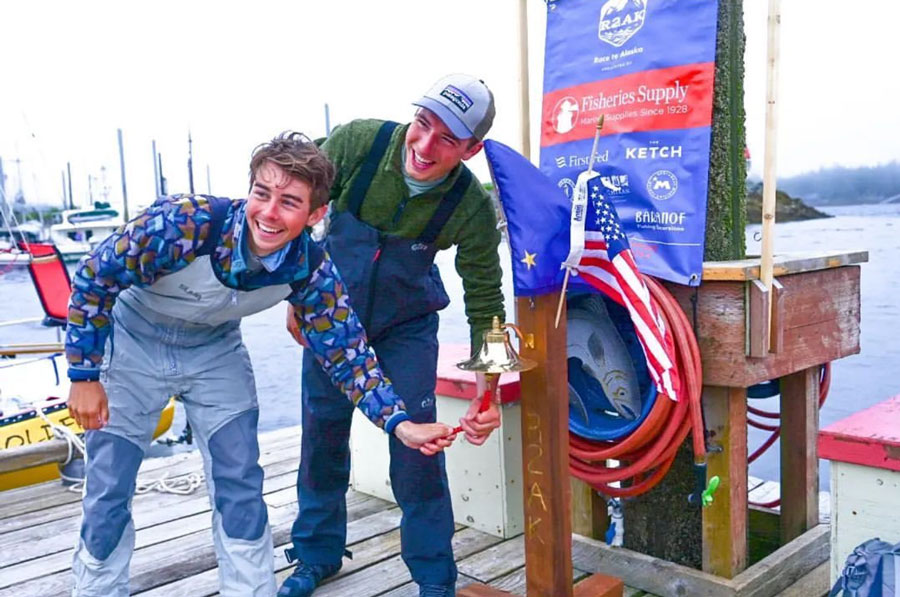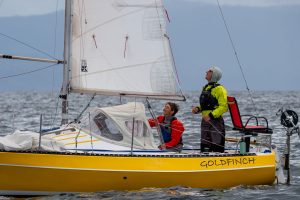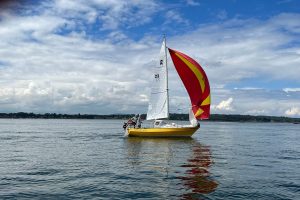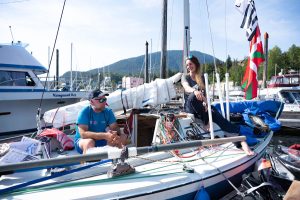Field Report
photo: Team Goldfinch by Rebecca Ross
Nine teams are still hunting for the engineless version of the gas pedal, and one ticked off their last mile to Ketchikan yesterday.
Caleb McDaniels and Sam Bonauto of Team Goldfinch picked up 13th place after a night anchored extremely close to Ketchikan—claims of adverse current abound, but we detected a slight smear of rouge above the drysuit collar. Four hours after finishing, Sam hemmed and hawed his way into admitting he wouldn’t recommend the race. “Why you so smiley then?”
“Well,” he said, “I try to be happy.”
Well, Sam, you picked an interesting way to find your happiness, didn’t you?
Caleb was barely twenty when he became the only solo sailor to finish our other adventure race, WA360. He came with a history of sailing and skillful suffering, growing up with FJs, Optis, and Lasers, and racing a fleet J105 as bow crew. He has rowed enough to win the US Rowing SW Junior Championship and 2017 SRAA National Championship. Built a boat. EMT certified. Hiked the PCT, logging a 24-hour record of 60.36 miles. Suffering, check.
He wasn’t able to find a second for his team, and let’s be honest, a 20-year-old casting about the waterfront proclaiming, “I’m gonna race a tiny ass engineless boat 750 miles up to Alaska, who’s in?” isn’t going to get a lot of takers. Last September, he met Sam at Bowdoin College and later mentioned he was looking for a second for his team. “Good luck with that,” Sam replied. Sam was pretty sure the whole thing felt “long and uncomfortable.” (We agree. An impressively accurate and succinct description.)
Sam was a regatta racer with a good list of accolades in races with ‘districts’ and ‘nationals’ in their titles. He liked to have fun, sail hard, then go home, and two out of three of those items likely wouldn’t occur racing to Alaska. Sam’s fall from racer to R2AKer has become a time-honored slide for many racers. Magnetism never asks if it’s a good idea to be attracted to a thing; it just goes there. In the end, Sam couldn’t resist the call of the adventure.
When the team finally came together, it was Caleb, Sam, and a Ranger 20 that neither of them had sailed. That doesn’t matter with a Ranger 20. It’s the Rocky of the sailing world before he hits the bags, moving just fast enough to feel like progress and stout enough to make up for bad navigation.
They gave themselves two weeks to complete the race and finished in just under twelve days. By all standards, it was an R2AK-worthy experience.
Caleb: “I never got cold. Except when my feet would go numb, but whatever.”
Sam: “I was pretty comfortable unless I was really uncomfortable, and when I was seasick.”
Which was right before they went aground. On Day Two, Goldfinch was sailing up the Strait of Georgia at midnight, but instead of relieving Caleb of the watch, Sam decided it was better to vomit for 11 hours until they anchored. When the tide started to leave them high and dry, they did the only thing they could: “We got out and pushed.”
The Ranger lived up to its tank-like reputation, with only one failure. Goldfinch was under full sail when they noticed the leeward spreader on the mast “had disconnected itself from the mast.” To get to the point, a spreader is one of the key ingredients to keeping a mast where it belongs, in the air. It’s attached to the mast and some wires that make the whole sailing thing work. It doesn’t get a vacation or a new job. It is designed to just be there, holding the mast in the air. “The nut fell out of the spreader, and it was just completely disconnected from the mast.” In proper R2AK form or fancy, when Sam noticed the spreader taking an unsanctioned holiday, he reached out his arm, and “the nut just fell into my hand.” That is a nut falling 15 feet from a boat in full sail; landing in the single place it could be useful. (Lottery tickets, anyone?)
In the ~12 days they raced, they established the Pooping Rail (which you won’t find in The Annapolis Book of Seamanship, because it’s the spot of the cockpit where you always, yes, poop), their pedal drive failed 1.5 times, and when they landed in Ketchikan, they didn’t know what was next. “I have a bike in Washington,” said Sam. “I think I’ll ride to school; I just have to get there before orientation.”
“In Maine? You’re going to ride to Maine?”
“Yeah.”
Yeah, that sounds about right.
Photos of Team Goldfinch by Rebecca Ross, Julian Laffin, and Heidi & Tor Baxter
Field Report: Crossing the Finish Line with the Kindness of Strangers and a Lot of Luck!
By Rebecca Ross, Field Reporter
One by one, the racers make their way across the finish line in Ketchikan, Alaska. And while I’m accustomed to hunting down racers for their stories, it just so happens that Boris and Nathalie of Team Loustic SuperSonic have some time on their hands—waiting until July 2nd to head back home to France.
I imagine every team by now, whether they left the race for any number of reasons, already finished, or are still out there eager to make it to the finish line, has stories to tell. And with Team Loustic—they certainly have stories worthy of sharing. Though they’ve probably already told their story several times in passing during the race, they graciously take a moment to share it with me—bouncing the details from one to the other seamlessly, as if it happened yesterday.
Boris and Nathalie walk me through the first mishap they encountered only hours into the Proving Ground as they headed towards Dungeness Spit. “Everything was very nice,” Nathalie recalls. “We were going so fast. We were even thinking about having fish and chips after arriving in Victoria.”… Keep Reading
